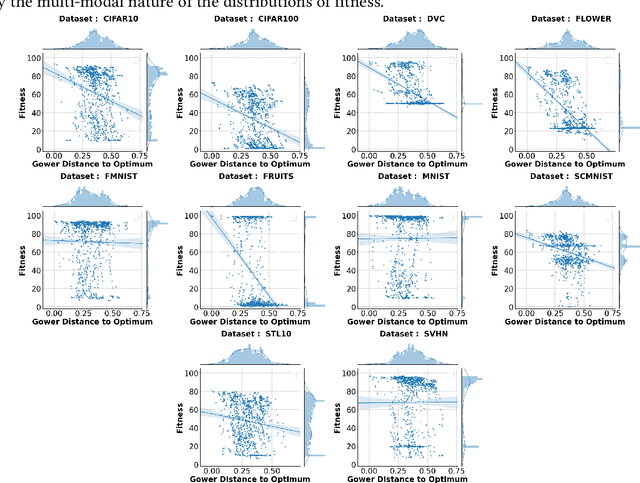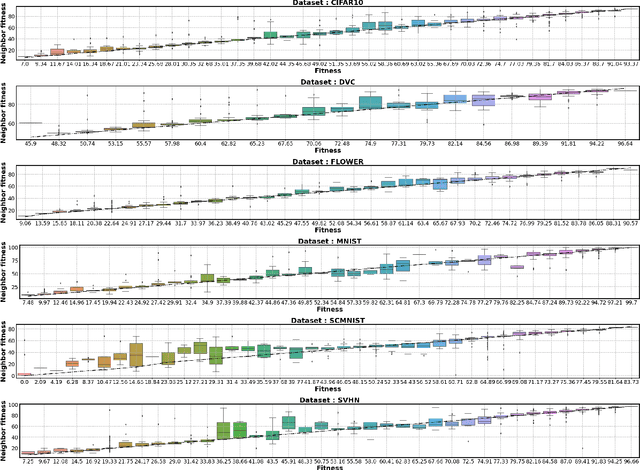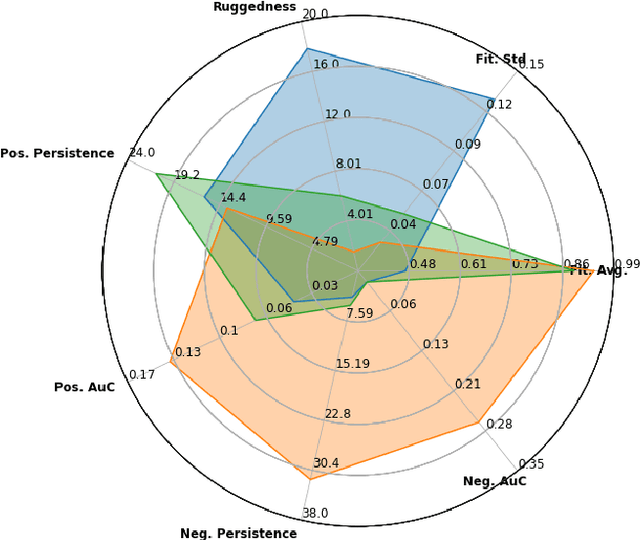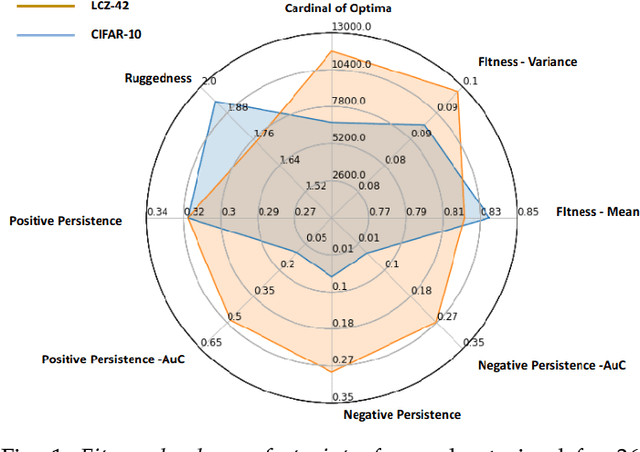Kalifou René Traoré
HPO: We won't get fooled again
Aug 04, 2022


Abstract:Hyperparameter optimization (HPO) is a well-studied research field. However, the effects and interactions of the components in an HPO pipeline are not yet well investigated. Then, we ask ourselves: can the landscape of HPO be biased by the pipeline used to evaluate individual configurations? To address this question, we proposed to analyze the effect of the HPO pipeline on HPO problems using fitness landscape analysis. Particularly, we studied the DS-2019 HPO benchmark data set, looking for patterns that could indicate evaluation pipeline malfunction, and relate them to HPO performance. Our main findings are: (i) In most instances, large groups of diverse hyperparameters (i.e., multiple configurations) yield the same ill performance, most likely associated with majority class prediction models; (ii) in these cases, a worsened correlation between the observed fitness and average fitness in the neighborhood is observed, potentially making harder the deployment of local-search based HPO strategies. Finally, we concluded that the HPO pipeline definition might negatively affect the HPO landscape.
Landscape of Neural Architecture Search across sensors: how much do they differ ?
Jan 20, 2022



Abstract:With the rapid rise of neural architecture search, the ability to understand its complexity from the perspective of a search algorithm is desirable. Recently, Traor\'e et al. have proposed the framework of Fitness Landscape Footprint to help describe and compare neural architecture search problems. It attempts at describing why a search strategy might be successful, struggle or fail on a target task. Our study leverages this methodology in the context of searching across sensors, including sensor data fusion. In particular, we apply the Fitness Landscape Footprint to the real-world image classification problem of So2Sat LCZ42, in order to identify the most beneficial sensor to our neural network hyper-parameter optimization problem. From the perspective of distributions of fitness, our findings indicate a similar behaviour of the search space for all sensors: the longer the training time, the larger the overall fitness, and more flatness in the landscapes (less ruggedness and deviation). Regarding sensors, the better the fitness they enable (Sentinel-2), the better the search trajectories (smoother, higher persistence). Results also indicate very similar search behaviour for sensors that can be decently fitted by the search space (Sentinel-2 and fusion).
A Data-driven Approach to Neural Architecture Search Initialization
Nov 05, 2021



Abstract:Algorithmic design in neural architecture search (NAS) has received a lot of attention, aiming to improve performance and reduce computational cost. Despite the great advances made, few authors have proposed to tailor initialization techniques for NAS. However, literature shows that a good initial set of solutions facilitate finding the optima. Therefore, in this study, we propose a data-driven technique to initialize a population-based NAS algorithm. Particularly, we proposed a two-step methodology. First, we perform a calibrated clustering analysis of the search space, and second, we extract the centroids and use them to initialize a NAS algorithm. We benchmark our proposed approach against random and Latin hypercube sampling initialization using three population-based algorithms, namely a genetic algorithm, evolutionary algorithm, and aging evolution, on CIFAR-10. More specifically, we use NAS-Bench-101 to leverage the availability of NAS benchmarks. The results show that compared to random and Latin hypercube sampling, the proposed initialization technique enables achieving significant long-term improvements for two of the search baselines, and sometimes in various search scenarios (various training budgets). Moreover, we analyze the distributions of solutions obtained and find that that the population provided by the data-driven initialization technique enables retrieving local optima (maxima) of high fitness and similar configurations.
Fitness Landscape Footprint: A Framework to Compare Neural Architecture Search Problems
Nov 02, 2021



Abstract:Neural architecture search is a promising area of research dedicated to automating the design of neural network models. This field is rapidly growing, with a surge of methodologies ranging from Bayesian optimization,neuroevoltion, to differentiable search, and applications in various contexts. However, despite all great advances, few studies have presented insights on the difficulty of the problem itself, thus the success (or fail) of these methodologies remains unexplained. In this sense, the field of optimization has developed methods that highlight key aspects to describe optimization problems. The fitness landscape analysis stands out when it comes to characterize reliably and quantitatively search algorithms. In this paper, we propose to use fitness landscape analysis to study a neural architecture search problem. Particularly, we introduce the fitness landscape footprint, an aggregation of eight (8)general-purpose metrics to synthesize the landscape of an architecture search problem. We studied two problems, the classical image classification benchmark CIFAR-10, and the Remote-Sensing problem So2Sat LCZ42. The results present a quantitative appraisal of the problems, allowing to characterize the relative difficulty and other characteristics, such as the ruggedness or the persistence, that helps to tailor a search strategy to the problem. Also, the footprint is a tool that enables the comparison of multiple problems.
 Add to Chrome
Add to Chrome Add to Firefox
Add to Firefox Add to Edge
Add to Edge